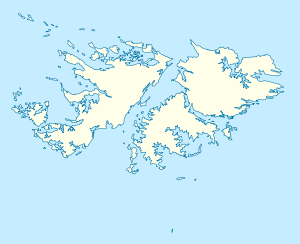Speedwell Island
| Isla Águila | |
|---|---|
 Satellite photo with Speedwell Island just below and to left of center | |
 Speedwell Island | |
| Geography | |
| Location | Atlantic Ocean |
| Coordinates | 52°13′10″S 59°43′00″W / 52.21944°S 59.71667°WCoordinates: 52°13′10″S 59°43′00″W / 52.21944°S 59.71667°W |
| Archipelago | Speedwell Island group |
| Area | 51.5 km2 (19.9 sq mi) |
| Length | 17.5 km (10.87 mi) |
| Width | 5 km (3.1 mi) |
| Administration | |
|
Falkland Islands | |
Speedwell Island (formerly Eagle Island; Spanish Isla Águila) is one of the Falkland Islands,[1] lying in the Falkland Sound, southwest of Lafonia, East Falkland.
The island has an area of 51.5 km2 (19.9 sq mi). It is about 17.5 km (10.9 mi) from north to south and 5 km (3.1 mi) wide at its central part. It is generally low-lying and has been used as a sheep farm for more than a hundred years.[2] It is separated from Lafonia by the Eagle Passage, which takes its name from Speedwell Island's old name. Speedwell Island is the largest of the Speedwell Island group, which includes the Elephant Cays, George Island, Barren Island and Annie Island.[2]
Ecology
The island is rodent-free, and thus a haven for penguins including the Magellanic penguin, which is the southernmost distributed species of the banded penguins. Various other nesting seabirds occur. The island is operated as a sheep farm.
History
In 1812 the British ship Isabella, captained by George Higton, was shipwrecked off "Eagle Island" (as it was then) Most of the crew were rescued by the American sealer Nanina, commanded by Captain Charles Barnard. However, realising that they would require more provisions for the expanded number of passengers, Barnard and a few others went out in a party to retrieve more food. During his absence the Nanina was taken over by the British crew and left them on the island. Barnard and his party were finally rescued in November 1814. In 1829 Barnard wrote A Narrative of the Sufferings and Adventures of Capt. Charles Barnard detailing the happenings.
The 1837 survey of the Falkland Islands under Lowcay noted that there were wild pigs on the island.
In 1929, Alexander Dugas, a Frenchman employed on Sealion Island committed suicide and his companions felt it necessary to inform the authorities. But the lack of harbors meant that no boat of any size could be kept on the island and so a determined individual called Benny Davis constructed a makeshift craft from wooden barrels and launched it into the surf. The remarkable sailor set out just before dark, and arrived at Speedwell Island some twelve hours later. He explained that he had simply headed west and then taken his direction from the smell of the cormorants on Annie Island.[3]
Important Bird Area
The Speedwell Island group (apart from the Elephant Cays which form a separate IBA) has been identified by BirdLife International as an Important Bird Area. Birds for which the site is of conservation significance include Falkland steamer ducks (600 breeding pairs), ruddy-headed geese, Magellanic penguins (10,000 pairs), southern giant petrels (1000 pairs), sooty shearwaters, striated caracaras, dolphin gulls (500 pairs), blackish cinclodes, Cobb's wrens and white-bridled finches.[2]
References
- ↑ William Wagstaff. 2001
- 1 2 3 "Speedwell Island Group". Important Bird Areas factsheet. BirdLife International. 2012. Retrieved 2012-10-20.
- ↑ http://www.ladatco.com/fk-sli.htm
- Ewen Southby-Tailyour. Falkland Island Shores
- Stonehouse, B (ed.) Encyclopedia of Antarctica and the Southern Oceans (2002, ISBN 0-471-98665-8)
- William Wagstaff. 2001. Falkland Islands: the Bradt Travel Guide
External links
- Satellite picture at the Wayback Machine (archived December 23, 2010)